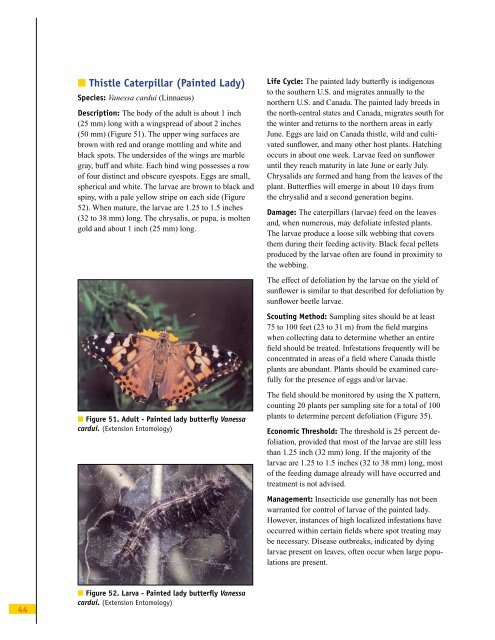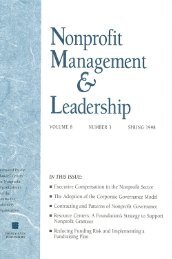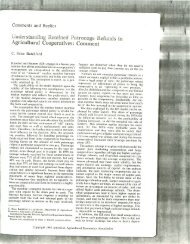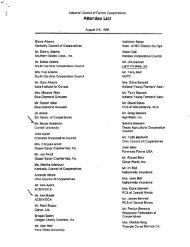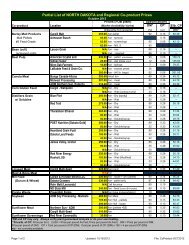Sunflower Production Field Guide - Your "Home Page"
Sunflower Production Field Guide - Your "Home Page"
Sunflower Production Field Guide - Your "Home Page"
Create successful ePaper yourself
Turn your PDF publications into a flip-book with our unique Google optimized e-Paper software.
44<br />
■ Thistle Caterpillar (Painted Lady)<br />
Species: Vanessa cardui (Linnaeus)<br />
Description: The body of the adult is about 1 inch<br />
(25 mm) long with a wingspread of about 2 inches<br />
(50 mm) (Figure 51). The upper wing surfaces are<br />
brown with red and orange mottling and white and<br />
black spots. The undersides of the wings are marble<br />
gray, buff and white. Each hind wing possesses a row<br />
of four distinct and obscure eyespots. Eggs are small,<br />
spherical and white. The larvae are brown to black and<br />
spiny, with a pale yellow stripe on each side (Figure<br />
52). When mature, the larvae are 1.25 to 1.5 inches<br />
(32 to 38 mm) long. The chrysalis, or pupa, is molten<br />
gold and about 1 inch (25 mm) long.<br />
■ Figure 51. Adult - Painted lady butterfl y Vanessa<br />
cardui. (Extension Entomology)<br />
■ Figure 52. Larva - Painted lady butterfl y Vanessa<br />
cardui. (Extension Entomology)<br />
Life Cycle: The painted lady butterfl y is indigenous<br />
to the southern U.S. and migrates annually to the<br />
northern U.S. and Canada. The painted lady breeds in<br />
the north-central states and Canada, migrates south for<br />
the winter and returns to the northern areas in early<br />
June. Eggs are laid on Canada thistle, wild and cultivated<br />
sunfl ower, and many other host plants. Hatching<br />
occurs in about one week. Larvae feed on sunfl ower<br />
until they reach maturity in late June or early July.<br />
Chrysalids are formed and hang from the leaves of the<br />
plant. Butterfl ies will emerge in about 10 days from<br />
the chrysalid and a second generation begins.<br />
Damage: The caterpillars (larvae) feed on the leaves<br />
and, when numerous, may defoliate infested plants.<br />
The larvae produce a loose silk webbing that covers<br />
them during their feeding activity. Black fecal pellets<br />
produced by the larvae often are found in proximity to<br />
the webbing.<br />
The effect of defoliation by the larvae on the yield of<br />
sunfl ower is similar to that described for defoliation by<br />
sunfl ower beetle larvae.<br />
Scouting Method: Sampling sites should be at least<br />
75 to 100 feet (23 to 31 m) from the fi eld margins<br />
when collecting data to determine whether an entire<br />
fi eld should be treated. Infestations frequently will be<br />
concentrated in areas of a fi eld where Canada thistle<br />
plants are abundant. Plants should be examined carefully<br />
for the presence of eggs and/or larvae.<br />
The fi eld should be monitored by using the X pattern,<br />
counting 20 plants per sampling site for a total of 100<br />
plants to determine percent defoliation (Figure 35).<br />
Economic Threshold: The threshold is 25 percent defoliation,<br />
provided that most of the larvae are still less<br />
than 1.25 inch (32 mm) long. If the majority of the<br />
larvae are 1.25 to 1.5 inches (32 to 38 mm) long, most<br />
of the feeding damage already will have occurred and<br />
treatment is not advised.<br />
Management: Insecticide use generally has not been<br />
warranted for control of larvae of the painted lady.<br />
However, instances of high localized infestations have<br />
occurred within certain fi elds where spot treating may<br />
be necessary. Disease outbreaks, indicated by dying<br />
larvae present on leaves, often occur when large populations<br />
are present.


